Street food offers a vibrant culinary experience, but it can pose significant risks for individuals with allergies due to cross-contamination and undisclosed ingredients. To enjoy these delights safely, it’s essential to identify allergen labels and choose vendors who prioritize allergen awareness. By asking questions about food preparation and understanding ingredient labels, consumers can make informed choices and minimize the risk of allergic reactions.
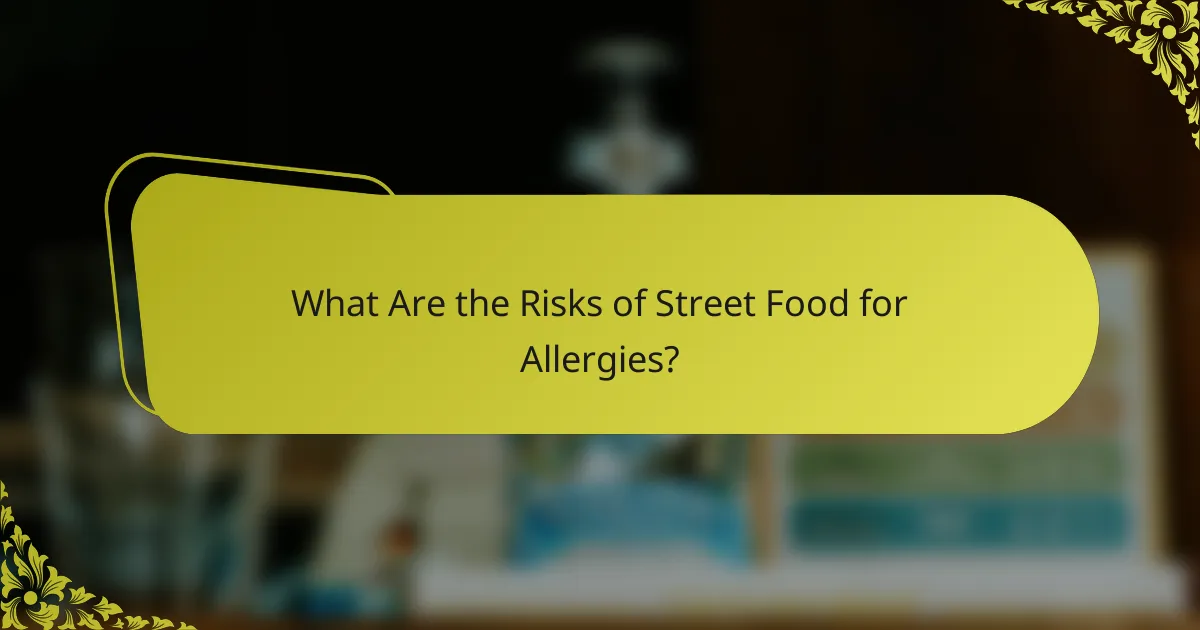
What Are the Risks of Street Food for Allergies?
Street food can pose significant risks for individuals with allergies due to factors like cross-contamination, undisclosed ingredients, and environmental allergens. Understanding these risks is crucial for making safe food choices while enjoying street cuisine.
Cross-contamination
Cross-contamination occurs when allergens from one food item come into contact with another, potentially exposing individuals to harmful substances. This is common in street food settings where utensils and cooking surfaces may not be thoroughly cleaned between uses.
To minimize the risk, ask vendors about their cooking practices and whether they use separate equipment for allergenic ingredients. If possible, observe the food preparation process to ensure that your meal is handled safely.
Undisclosed ingredients
Street food vendors may not always provide complete ingredient lists, making it difficult for those with allergies to make informed choices. Some ingredients, especially common allergens like nuts, dairy, or gluten, may be hidden in sauces or marinades.
Always inquire about the ingredients used in your meal and request modifications if necessary. If a vendor cannot provide clear information, it may be safer to choose another option.
Environmental allergens
Environmental allergens, such as pollen or dust, can also be a concern when consuming street food. These allergens can settle on food items or cooking surfaces, especially in outdoor settings.
To reduce exposure, consider eating during times when pollen counts are lower, such as early morning or after rain. Additionally, choosing food from vendors who maintain clean and organized stalls can help mitigate this risk.

How to Identify Allergen Labels on Street Food?
Identifying allergen labels on street food is crucial for safe consumption, especially for individuals with food allergies. Vendors are often required to provide clear labeling that highlights common allergens, making it easier for consumers to make informed choices.
Understanding food labeling laws
Food labeling laws vary by country, but many places have regulations that require food vendors to disclose allergen information. In the United States, for instance, the Food Allergen Labeling and Consumer Protection Act mandates that major allergens be clearly listed on packaged foods. Street food vendors may not always follow these regulations strictly, so it’s essential to ask about ingredients directly.
In the European Union, similar regulations exist, requiring food businesses to inform consumers about allergens present in their offerings. Vendors must provide this information either on menus or through verbal communication, ensuring that customers can make safe choices.
Common allergens to look for
When assessing street food for allergens, be aware of the most common allergens, which include peanuts, tree nuts, dairy, eggs, fish, shellfish, soy, and wheat. These ingredients can often be hidden in sauces, dressings, or breading, so thorough inquiry is necessary.
It’s advisable to ask vendors specific questions about their food preparation methods, as cross-contamination can occur even if a dish does not contain a known allergen. For example, if a vendor fries items in the same oil, there may be a risk for those allergic to shellfish or gluten.
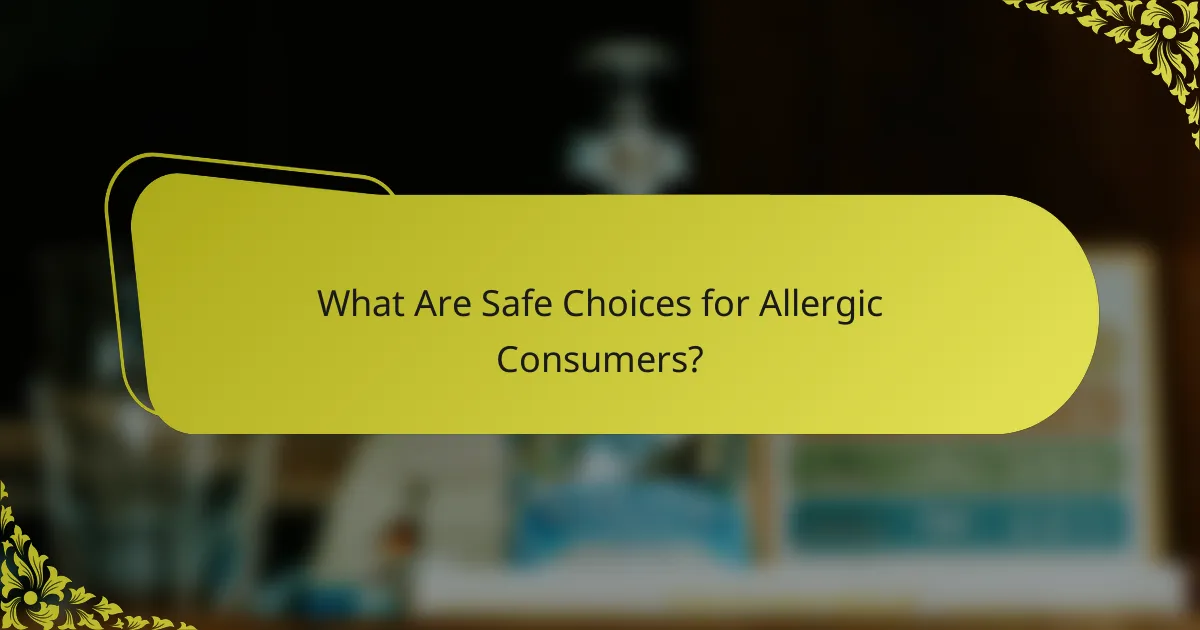
What Are Safe Choices for Allergic Consumers?
Safe choices for allergic consumers involve selecting street food vendors who prioritize allergen awareness and practicing safe food handling. Understanding ingredient labels and asking questions about food preparation can significantly reduce the risk of allergic reactions.
Trusted street food vendors
Choosing trusted street food vendors is crucial for allergic consumers. Look for vendors who clearly display their ingredient lists and are knowledgeable about allergens. Recommendations from local food safety authorities or community reviews can help identify reliable options.
Additionally, vendors who participate in food safety training programs or have certifications often demonstrate a commitment to safe practices. Observing cleanliness and food handling procedures can also indicate a vendor’s reliability.
Safe food preparation practices
Safe food preparation practices are essential for minimizing allergen exposure. Vendors should use separate utensils and cooking surfaces for allergenic ingredients to prevent cross-contamination. Regularly cleaning equipment and surfaces can further enhance safety.
Consumers should feel empowered to ask vendors about their preparation methods. Inquire whether they have protocols for handling allergens, such as dedicated cooking areas or specific cooking times to avoid cross-contact. This proactive approach can help ensure a safer dining experience.
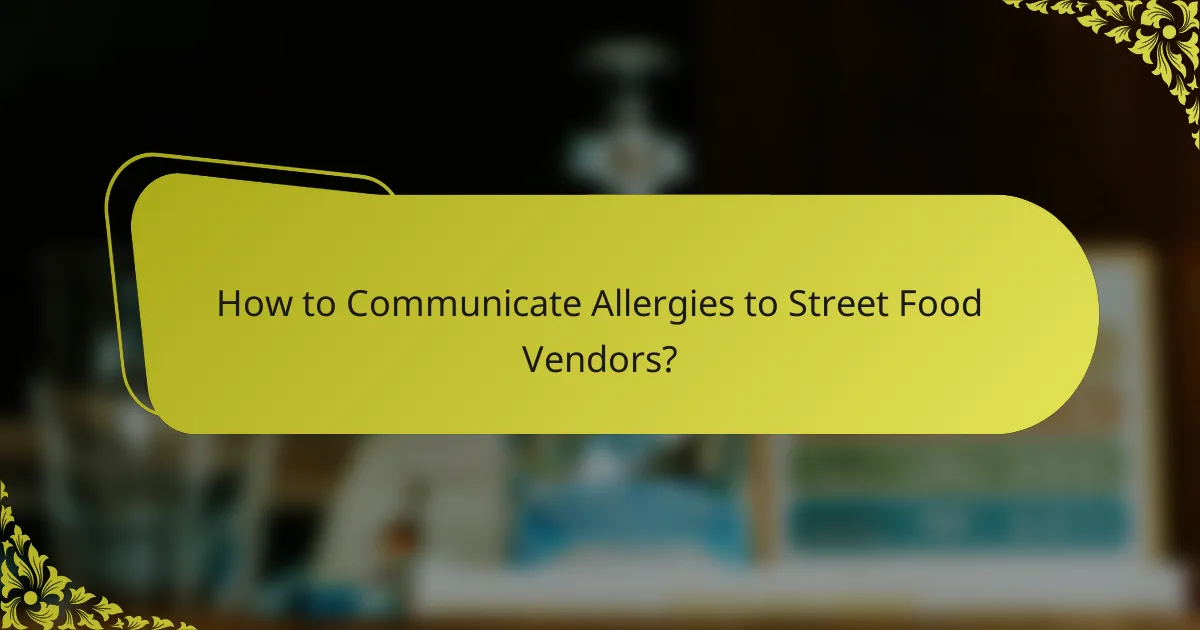
How to Communicate Allergies to Street Food Vendors?
To effectively communicate allergies to street food vendors, be clear and direct about your specific dietary restrictions. Use simple language and ensure the vendor understands the severity of your allergies to avoid any potential health risks.
Effective communication strategies
Start by approaching the vendor when they are not busy to ensure they can focus on your request. Use visual aids, such as allergy cards or smartphone apps, to help convey your needs if language barriers exist. Always repeat your allergies back to the vendor to confirm understanding.
Consider asking about the ingredients in dishes and how they are prepared. This can help you gauge the risk of cross-contamination. If possible, choose vendors who are known for their awareness of food allergies and safe food handling practices.
Key phrases to use
Use clear phrases like “I have a severe allergy to [specific food]” or “Can you confirm if this contains [specific allergen]?” This direct approach helps convey the seriousness of your situation. Phrases like “Please use separate utensils” can also be effective in preventing cross-contact.
It may be helpful to say, “I cannot eat anything that has been in contact with [allergen]” to emphasize your needs. If you’re unsure about a dish, asking “What ingredients are in this?” can provide clarity and help you make safe choices.
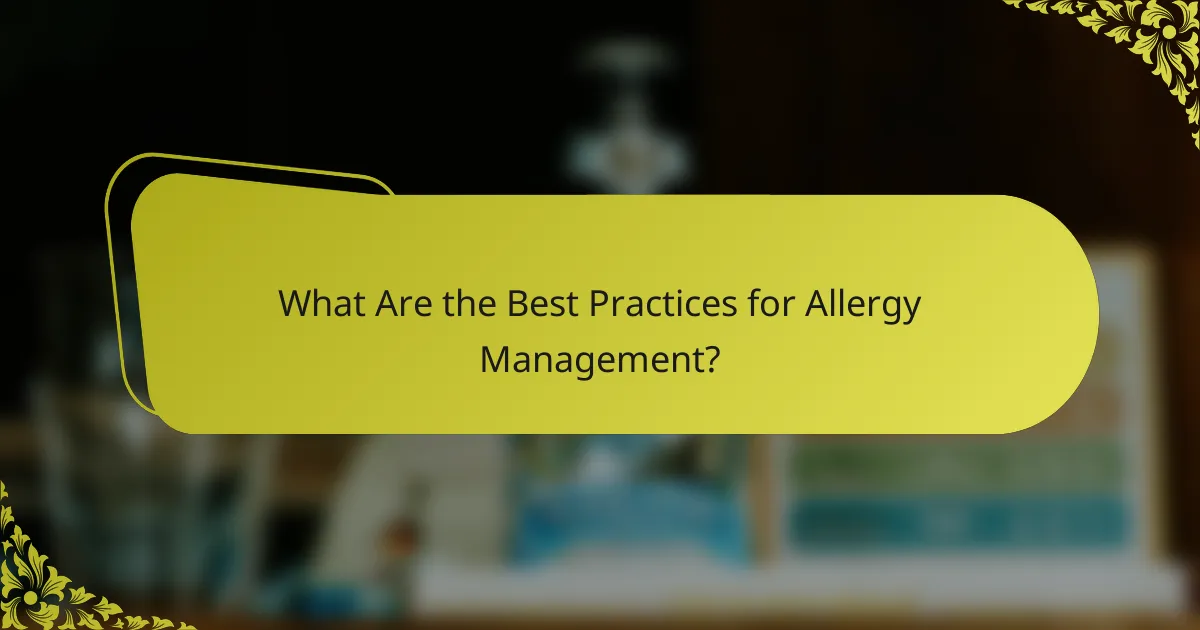
What Are the Best Practices for Allergy Management?
Effective allergy management involves proactive strategies to minimize exposure to allergens and ensure quick responses in case of accidental exposure. Key practices include carrying emergency medication and creating a detailed allergy action plan.
Carrying emergency medication
Always carry prescribed emergency medications, such as epinephrine auto-injectors, if you have severe allergies. These should be readily accessible and stored in a temperature-controlled environment to ensure they remain effective.
Check the expiration dates regularly and replace any expired medications. Inform friends, family, and coworkers about your allergies and how to use your emergency medication in case of an allergic reaction.
Creating an allergy action plan
An allergy action plan outlines specific steps to take in case of an allergic reaction. This plan should include information about your allergies, symptoms to watch for, and the proper use of emergency medications.
Share your action plan with caregivers, schools, and workplaces. Regularly review and update the plan as needed, especially when your allergy status changes or when new medications are prescribed.
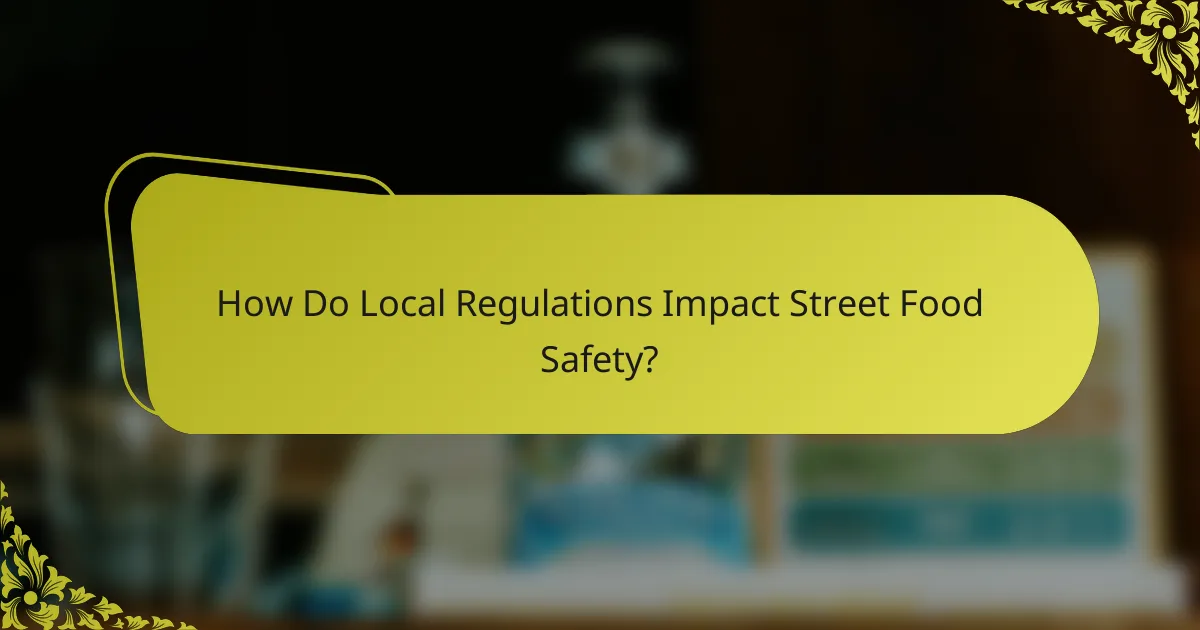
How Do Local Regulations Impact Street Food Safety?
Local regulations play a crucial role in ensuring the safety of street food by establishing standards for hygiene, food handling, and vendor practices. These regulations vary by region and can significantly influence the quality and safety of food available to consumers.
Health department guidelines
Health department guidelines outline the necessary practices for food safety that street food vendors must follow. These include maintaining proper food temperatures, ensuring cleanliness, and using safe food handling techniques. Vendors are often required to undergo training and inspections to comply with these standards.
For example, many jurisdictions mandate that food must be kept at safe temperatures, typically below 5°C (41°F) for cold items and above 60°C (140°F) for hot items. Failure to adhere to these guidelines can lead to penalties or the closure of the vendor’s operation.
Licensing requirements for vendors
Licensing requirements for street food vendors vary widely and are essential for legal operation. Most areas require vendors to obtain a food service license, which often involves submitting an application, paying a fee, and passing health inspections. This process helps ensure that vendors meet local health and safety standards.
In many cities, vendors must also display their licenses prominently at their stalls, allowing customers to verify their legitimacy. It’s advisable for consumers to look for these licenses as a quick check of vendor compliance with local regulations.

What Are the Trends in Allergy-Friendly Street Food?
Allergy-friendly street food is gaining popularity as vendors adapt to the growing demand for safe dining options. Consumers are increasingly seeking meals that cater to common allergens, leading to innovative solutions in food preparation and labeling.
Emerging allergen-free options
Street food vendors are introducing a variety of allergen-free options to accommodate customers with dietary restrictions. These include gluten-free wraps, nut-free desserts, and dairy-free alternatives, often made with ingredients like quinoa, chickpeas, and coconut. Many vendors are also experimenting with plant-based proteins to create safe and appealing meals.
For example, a food truck might offer a gluten-free falafel wrap made with chickpea flour, ensuring that it is safe for those with gluten sensitivities. Additionally, some vendors are focusing on cross-contamination prevention by using separate cooking equipment for allergen-free items.
Innovative food labeling technologies
Advancements in food labeling technologies are enhancing transparency for consumers with allergies. QR codes and mobile apps are becoming common, allowing customers to access detailed ingredient lists and allergen information instantly. This technology helps diners make informed choices while ordering street food.
Moreover, some vendors are adopting color-coded labeling systems to indicate allergen-free items clearly. For instance, a green label might signify a dish that is free from the top eight allergens, making it easier for customers to identify safe options quickly.

How Can Consumers Advocate for Better Allergy Awareness?
Consumers can advocate for better allergy awareness by actively engaging with food vendors and local authorities to promote clear labeling and safe food handling practices. This involves raising awareness about food allergies, participating in community discussions, and supporting initiatives that prioritize allergen safety.
Engaging with local food councils
Engaging with local food councils is a practical step for consumers to influence allergy awareness in their communities. These councils often include representatives from various sectors, including food vendors, health officials, and consumers, creating a platform for dialogue about food safety and allergen management.
To effectively engage, attend council meetings and voice concerns regarding allergen labeling and safety practices. Bringing personal experiences can highlight the importance of clear communication regarding food allergies, encouraging vendors to adopt better practices.
Additionally, consider collaborating with local advocacy groups focused on food allergies. This can amplify your voice and help in organizing campaigns or educational workshops that inform both consumers and food providers about the risks and necessary precautions related to food allergies.
